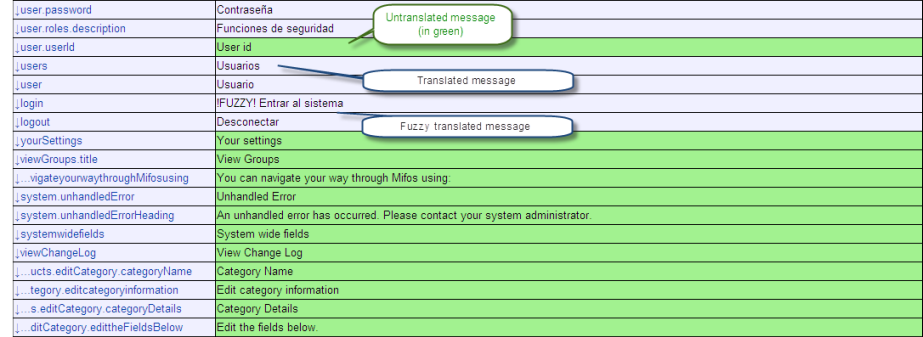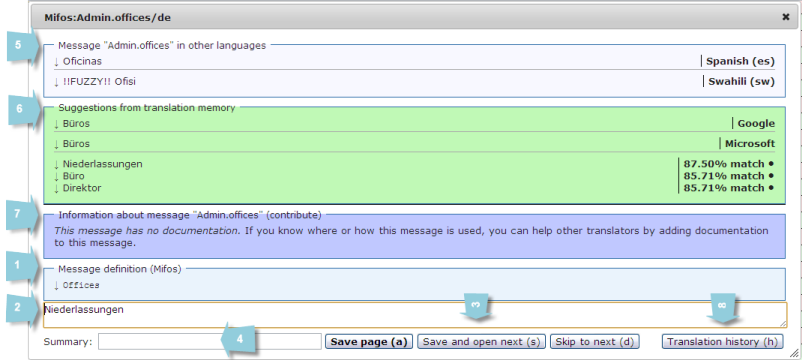Online Translation HOWTO - TWN
So you want to translate Mifos? Read on to learn how. Mifos is now using Translatewiki.net (TWN) for the online translation of "messages" (formerly called strings) in Mifos. This replaces our previous tool, Pootle, which has now been deprecated.
Getting Translation Privileges
Go to the Translatewiki.net homepage and click the "Start Translating" button. You'll be prompted with a Getting Started Wizard that has the following steps to follow.
- Sign up for an account.
- From the Getting Started Wizard, follow the steps for creating an account.
- You will be sent a confirmation e-mail. Please confirm to activate e-mail features on your account.
- Log in to continue the process to get translation privileges
- Configure your preferences
- Click the link at the top of the page titled "My Preferences."
- IMPORTANT - There is a known issue with having the Language setting for Internationalization under the User Profile preference be set to "en". Set it to your actual language, if this is English set it to "en-GB". This is necessary to successfully go through this process.
- Another useful setting under preference is the "Assistant languages" setting under the "Editing" preferences. Set this to the language you'll be translating in to and you'll get a helpful translation assistant with suggested translations.
- Configure any other preferences as needed and click "Save"
- On the wizard page, click the "I'm done. Let me proceed." button to move forward with creating a user page.
- Create your user page
- This page lets us and the TWN community know who you are, what languages are your strong points, and where you can help.
- On the wizard page you should be prompted with a form to create a new user page. Follow the directions provided in the wizard to specify your languages and your proficiency in them. Make sure your markup matches the correct format.
- Write a quick bio stating who you are, and what languages you'll be translating into.
- Click "Save"and follow the steps to submit your user page. Once successful, the wizard should reflect the that the first three steps of "Getting Started" are done.
- (If this form doesn't appear, you can create the user page manually by clicking your user name at the top of the page - from there you will see a link to edit this page if one doesn't exist.)
- Request translator permissions
- From the Getting Started Wizard, click the Project:Translator link to create a wiki page to request translation privileges. From there follow the directions to submit a request stating what language you would like to translate to and for what project.
- Your request will be approved as soon as possible. Usually this approval is quite quick but could take up to a day.
- Start translating
- Once your request is approved, follow steps below:
Using the Tool
Details on Each Step can be found below:
- Fetch Messages to Translate
- Translate messages
- Consistent use of translations is very important.This can be difficult to achieve with multiple individuals translating and various translations that could be used.
- Use the old translation file as a reference. If you're not 100% sure of the translation, look for that message in previous translation file.
- View suggestions from translation memory. This will show current instances of how this message has been translated.
- Use our Glossary of Terms. Here we'll list terms with multiple potential translations and the designated translation to use. Edit this page and list any terms that come into question.
- Consistent use of translations is very important.This can be difficult to achieve with multiple individuals translating and various translations that could be used.
Fetch Messages to Translate
First you need to fetch the messages in Mifos you'll want to translate. The quickest way to start translating is from the Mifos homepage on translatewiki.net by clicking Translate this Project . This will take you to the Special:Translate page. Below are some tips on fetching messages most efficiently.
- Under the “I want to” box, select which messages you’d like to view. For translation purposes this will most often be “View all untranslated messages from” This is where you can also review translations that have already been submitted, all messages, etc.
- Under the “Group” box you can select which project you will be translating. For Mifos, you have the option of selecting “All Mifos messages” or just certain sections of Mifos.
- Under “Language”, this is where you select the language you will be translating into.
- Under "Limit", you can select the number of messages to display per page.
The status of messages are color-coded.
- Untranslated messages are green.
- Translated messages are grey
- Fuzzy translated messages are also grey
Translate Messages
Once you've fetched your messages you'll click which message you want to translate. For each message, you'll see a pop-up window like below. Here's what each field means. The quickest way to translate multiple messages is to enter your translation and then click "Save and open next [message]".
- Message definition - This is the message you are translating.
- This text field is where you enter your translation.
- Navigation buttons - The quickest way to translate multiple messages in succession is to click "Save and open next"
- Save page (a) - Saves the current translated message. (Keyboard shortcut is alt-a)
- Save and open next (s): Saves the current translated message and opens the next one for translation in same window. (Keyboard shortcut is alt-s)
- Skip to next (d): If you don't know a good translation for the message, click this to skip. (Keyboard shortcut is alt-d)
- Summary - This is where notes about your translation can be typed
- Message in other languages - Based on what languages you specify in your translation assistant preferences, this will display the translation of these messages in other languages. I've
- Suggestions from translation memory - TWN has a very powerful and useful feature that provides suggestion for translating the message from public search engines.
- Information about message - this documentation field provides an explanation of what this message means or the context of how it is used. If documentation is available it will be in this box; if there is no documentation, feel free to add an explanation by clicking "contribute".
- Translation history - any previous changes made to the translation will be displayed here.
Reviewing Translated Messages
To review translations that have been made, from the Specialist:Translate page, select: "Review all translated messages in" from the "I want to" dropdown. This will list all the messages in English and its corresponding translation:
Translations can be exported into .po/gettext format from the Special:Translate page by selecting from the "I Want to" menu, "Export translation in Gettext format". These translations can then be opened with a .po editor like Poedit
Viewing Progress on Translations
To see the progress of how many messages have been translated into your language, go to the Mifos Project stats page. These statistics are updated daily. Click recent changes to see translations that have been made but not yet updated in the stats.
Questions
Not 100% sure of the proper message translation?. What do I do? (!FUZZY!)
If the suggestions from translation memory or the translation assistants from the tool do not help, you can look for the previously translated string which should be quite similar in our old .po files. You can get these old .po files from here. If still not sure, make it fuzzy. That way it’ll be flagged for us to look at later. You can manually mark a message Fuzzy by inserting !FUZZY! at the beginning of your translation
Some messages are automatically marked fuzzy. More on fuzzy translations: http://translatewiki.net/wiki/FAQ#!!FUZZY!!.
Can't find your language?
Unlike with Pootle, there's no delay in adding in your language to be translated. One huge benefit of TWN is the number of languages already supported.
If you look at the Mifos project stats page and do not see your language listed, no one has started translating it yet and we need your help. From the translation tool, simply select the language you want to translate in and start translating. The language will then show up on the progress page by the next day. That's one great benefit.
If the language is not currently supported by translatewiki.net, please contact the TWN community in the #mediawiki-i18n IRC channel on irc.freenode.net.



